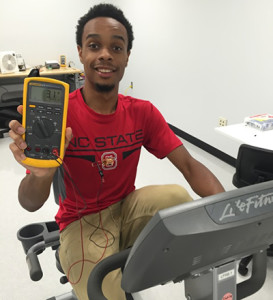Above: The National Science Foundation ASSIST lab at North Carolina State University
Embedded Sensors Could Monitor Health

NCSU’s Melissa Hyland and Haywood Hunter present how to to convert body heat into electricity. Credit: NCSU
North Carolina State University (NCSU) researchers want future wearable electronics to never lose power. In response, NCSU created a novel way to convert body heat, from our upper arms, into electricity to operate embedded sensors.
[Watch how NSCU began its body heat to electricity research.]
The prototypes are body-hugging, and the NCSU Department of Electrical and Computer Engineering says the clothes “can generate far more electricity than previous lightweight heat harvesting technologies.”
The previous problem: Associate professor says Daryoosh Vashaee, the research leader, was that the way to convert body heat used “heavy, stiff, and bulky” material that dispersed heat from another object. The technique also only generated only one microwatt or less of power per centimeter squared (µW/cm2).
NCSU’s solution: Developing a layer of thermally conductive material that rests on the skin and disperses heat. But a polymer coating atop the material “prevents the heat from dissipating through to the outside air.”
The new approach Vashaee says generates up to 20 µW/cm2 and discarding bulky material created lighter, more comfortable clothing.
Vashaee worked on the project as part of the National Science Foundation’s Nanosystems Engineering Research Center for Advanced Self-Powered Systems of Integrated Sensors and Technologies (ASSIST) department at NCSU.

Veena Misra
Misra is the Director of the National Science Foundation ASSIST Center. She earned her PhD, MS, and BS degrees in Electrical Engineering at North Carolina State University.
Body heat conversion paper lead authors

Melissa Hyland is a Research Assistant, and a student, at NCSU State studying for a BS in Civil Engineering. She previously received a Bachelor of Science degree in Earth Science from the University of North Carolina at Charlotte in 2014.

Haywood Hunter is an undergraduate researcher with ASSIST, and a senior majoring in Electrical Engineering.
[Get info on the NCSU Summer Research program at ASSIST, here.]
NCSU body heat conversion paper lead co-authors

Elena Nicolescu Veety is Education Director of ASSIST NERC (Nanosystems Engineering Research Center). She received her PhD in Electrical Engineering and her BS in Electrical Engineering, Computer Engineering from NCSU.
Jie Liu, no photo available, is a postdoctoral researcher at NC State
The heat conversion research was funded by the National Science Foundation and by the Air Force Office of Scientific Research.
Vashaee says that “goal of ASSIST is to make wearable technologies that can be used for long-term health monitoring, such as devices that track heart health or monitor physical and environmental variables to predict and prevent asthma attacks.”
The paper, “Wearable thermoelectric generators for human body heat harvesting,” is published in the journal Applied Energy.







